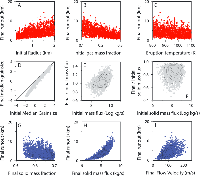Insights into the formation and dynamics of coignimbrite plumes from one-dimensional models
Engwell, S. L., M. de’ Michieli Vitturi, T. Esposti Ongaro, & A. Neri (2016)
Journal of Geophysical Research: Solid Earth, 121, 6, 4211–4231, doi:10.1002/2016JB012793
Abstract
Coignimbrite plumes provide a common and effective mechanism by which large volumes of fine-grained ash are injected into the atmosphere. Nevertheless, controls on formation of these plumes as a function of eruptive conditions are still poorly constrained. Herein, two 1-D axysymmetric steady state models were coupled, the first describing the parent pyroclastic density current and the second describing plume rise. Global sensitivity analysis is applied to investigate controls on coignimbrite plume formation and describe coignimbrite source and the maximum plume height attained. For a range of initial mass flow rates between 108 and 1010 kg/s, modeled liftoff distance (the distance at which neutral buoyancy is attained), assuming radial supercritical flow, is controlled by the initial flow radius, gas mass fraction, flow thickness, and temperature. The predicted decrease in median grain size between flow initiation and plume liftoff is negligible. Calculated initial plume vertical velocities, assuming uniform liftoff velocity over the pyroclastic density current invasion area, are much greater (several tens of m/s) than those previously used in modeling coignimbrite plumes (1 m/s). Such velocities are inconsistent with the fine grain size of particles lofted into coignimbrite plumes, highlighting an unavailability of large clasts, possibly due to particle segregation within the flow, prior to plume formation. Source radius and initial vertical velocity have the largest effect on maximum plume height, closely followed by initial temperature. Modeled plume heights are between 25 and 47 km, comparable with Plinian eruption columns, highlighting the potential of such events for distributing fine-grained ash over significant areas.
http://onlinelibrary.wiley.com/doi/10.1002/2016JB012793/full


